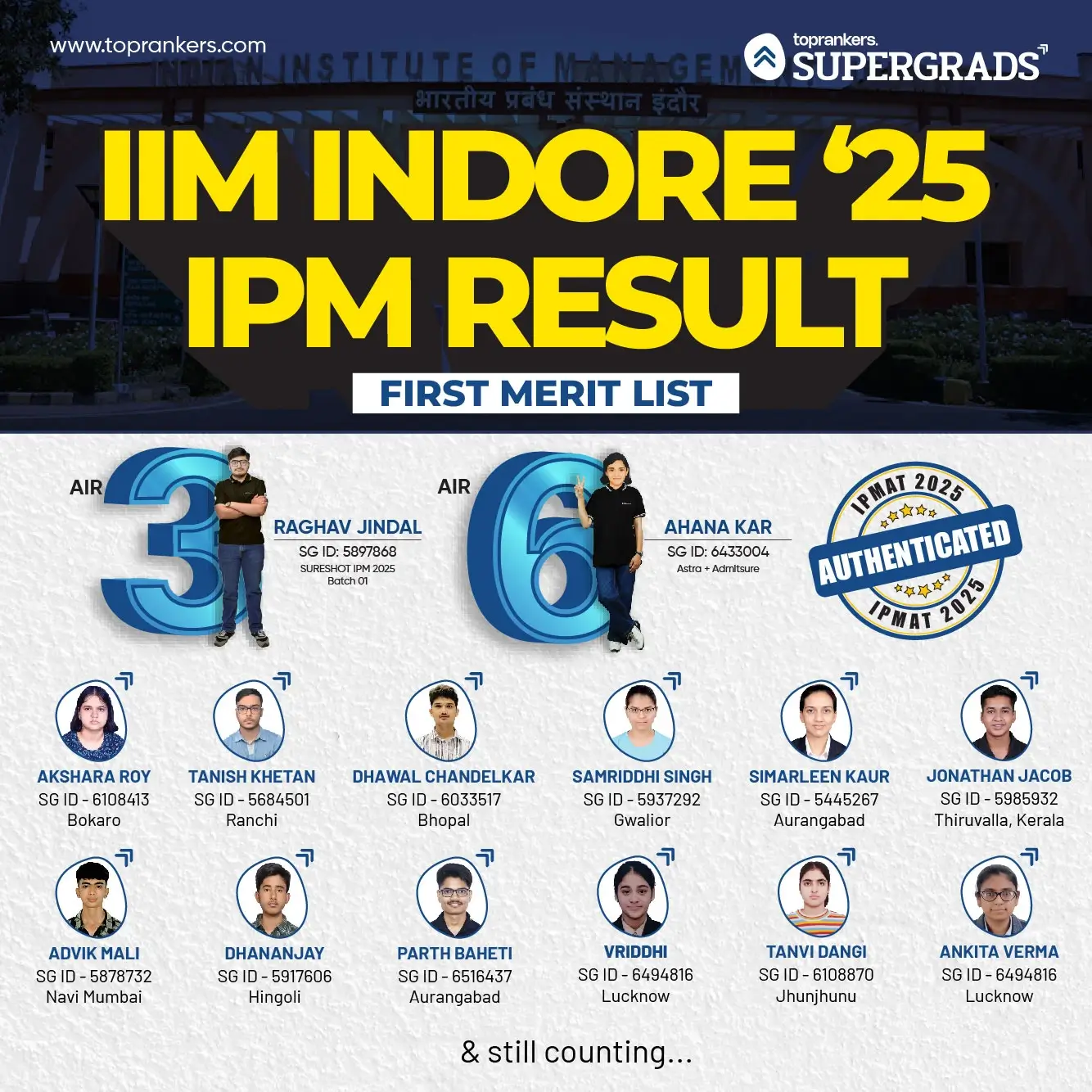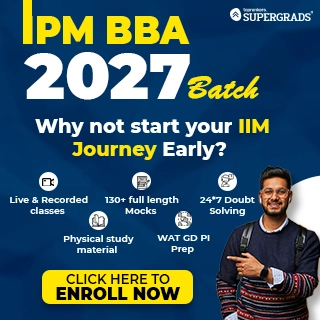Download IPMAT Maths Syllabus 2026 PDF [Section Wise ]
October 29, 2025
Overview: Want to get familiar with the IPMAT Maths Syllabus 2026? In this guide, you will find topic-wise syllabus breakdowns, preparation tips, and a marking scheme for quants.
Planning for IPMAT 2026?
The first step towards success is to have a good hold over the IPMAT Maths Syllabus 2026.
It will provide you with a good understanding of the logical ability, arithmetical skills, and speed required under stress. We have segregated the entire maths syllabus IPMAT, including the essential topics you must know, how to prepare, and a bonus IPMAT Mathematics Syllabus PDF to take home.
Let's master the IPMAT syllabus for maths, whether you're just starting or revising.
Table of Contents
IPMAT Maths Syllabus 2026 Overview
The IPM Maths Syllabus 2026 is the mainstay of the Quantitative Ability section of the Integrated Program in Management Aptitude Test (IPMAT) exam.
This part tests the numerical knowledge, logical thinking and problem-solving capability of a candidate using questions whose answer lies in Class 10 to 12 math concepts.
The IPMAT maths syllabus covers concepts such as arithmetic, algebra, geometry, number system and modern math.
Overall, the IPMAT Maths section will have 50 questions (a combination of multiple-choice (MCQs) and short-answer (SA) questions) to be attempted in 80 minutes.
The maths syllabus of IPMAT can be said to be of varying degrees of difficulty, easy to moderate-difficult, again depending on the topic.
It is wise to have a good grip on all the significant concepts and keep the IPMAT Mathematics Syllabus PDF alongside to enhance accuracy, time management, and stand a better chance of cracking this competitive exam.
IPMAT Maths Syllabus PDF Download Link
Important Topics in IPMAT Maths Syllabus 2026
Check out the table below to understand the maths syllabus for IPMAT in the quantitative ability section.
Section-Wise Breakdown of IPMAT Maths Syllabus 2026
| Number System | Averages & Percentages | Profit & Loss | Linear & Quadratic Equations | Ratio & Proportions |
| Simple & Compound Interest | Mixtures & Allegations | Time, Speed & Distance | Work, Pipes & Cisterns | Geometry: Lines, Angles & Triangles |
| Partnerships | Polygons, Circles & Mensuration | Logarithms | Permutations & Combinations | Probability |
| Roots, Indices & Surds | Matrices & Determinants | Functions | Heights & Distance | Sequence & Series |
| Vectors | Divisibility | HCF & LCM | Boats & Streams | Problems on Age |
IPMAT Maths Syllabus 2026: Topic Weightage & Trends
Quantitative Aptitude (MCQ)
| Topic | No. of Questions (2025) |
No. of Questions (2024) |
| LRDI Set / Data Arrangement | 5 | 5 |
| Matrices and Determinants | 1 | - |
| Arithmetic/Geometric Progression | 2 (AP, GP + GP Concept) | 2 (with Log) |
| Permutation and Combination | 2 | 2 |
| Probability | 1 | - |
| Remainders | 1 | - |
| Number System | 1 | - |
| Time, Speed, Distance (TSD) | 1 | 1 |
| Coordinate Geometry | 2 | 3 |
| Geometry (Polygon, General) | 1 (Octagon) | 1 |
| Logarithms | 1 (with Proportion) | 2 |
| SICI | 1 | 1 |
| Basic Algebra | - | 1 |
| Modulus Function | - | 1 |
| Trigonometry / Heights & Distance | - | 1 |
| Profit & Loss | - | 1 |
| Set Theory | - | 2 |
Quantitative Aptitude (SA)
| Topic | No. of Questions (2025) |
No. of Questions (2024) |
| Age | 1 | - |
| Logarithm | 2 | 1 |
| Time and Work | 1 | - |
| Geometry (Circle/Square, Mens.) | 1 | 1 |
| LRDI Set / Data Interpretation | 3 | - |
| Remainder Theorem (Algebra) | 1 | - |
| AP/GP | 1 | - |
| Modulus / Inequality | 1 | 1 |
| Determinants and Matrices | 1 | 1 |
| Number of Integral Solutions | 1 | - |
| Set Theory | - | 1 |
| Percentage | - | 1 |
| SICI | - | 1 |
| Counting | - | 1 |
| Quadratic Equation | - | 1 |
| Number System | - | 1 |
| Ratio | - | 1 |
| Function | - | 1 |
| Mean, Median (Set-Based) | - | 3 |
IPMAT Maths Marking Scheme 2026
The most effective way to approach the IPMAT Maths syllabus 2026 is to understand the IPMAT marking scheme.
| Section | Question Type | Marks per Que |
Negative Marking |
| Quantitative Ability (MCQ) | Multiple Choice | 4 | -1 |
| Quantitative Ability (SA) | Short Answer | 4 |
No Negative Marking |
The table above implies that attempting SA questions is less risky compared to MCQs.
This point can be kept in mind when attempting practice papers, which will help you improve your approach to the maths syllabus for IPMAT.
How to Prepare for the IPMAT Maths Syllabus 2026?
By following these tips, candidates can enhance their mathematical skills and boost their confidence for the IPMAT and beyond.
1. Strengthen Basic Mathematical Foundations
Focus on these key areas to build a strong mathematical foundation.
| Topic | Subtopics | Recommended Resources |
| Arithmetic | Percentages, Ratios, Profit and Loss, Time-Speed-Distance, Averages | NCERT textbooks |
| Algebra | Linear Equations, Quadratic Equations, Inequalities, Functions | High school algebra books, Alcumus |
| Number Systems | Divisibility, Prime Numbers, HCF, LCM, Basic Properties | "Number Theory" by George Andrews |
| Geometry and Mensuration | Properties of Triangles, Circles, Quadrilaterals, Area and Volume Formulas | "Elementary Geometry" by John Roe |
Check: IPMAT Maths Important Formulas
2. Develop Advanced Problem-Solving Techniques
Solving the IPMAT problems does not merely require knowledge of mathematical concepts. It demands tactical reasoning skills.
The first step would be to identify the kind of question at a glance and be able to spot the common patterns to minimise the time spent solving.
Employ effective computing techniques such as shortcuts and tricks to improve both speed and accuracy.
The most effective way to enhance your quantitative ability skills for IPMAT is to ensure that you get into the habit of solving a variety of problems within set timings, in a manner that is reminiscent of the IPMAT exam stress.
3. Master Time Management
Time management in the IPMAT is very important so that you can attempt all questions without hurrying.
Start with questions that you are sure of to get some easy marks and gain confidence.
Set definite time restrictions on each question to keep a regular pace within the paper.
Timed IPMAT mock tests will help you develop stamina and improve your time management.
As a practical tip, whenever practising, set a timer to mimic the actual exam conditions, as well as to work on pacing.
4. Utilise Past Year Papers and Mock Tests
Mock tests are one of the best methods to revise the IPMAT Maths Syllabus 2026 and improve your overall preparation.
By solving previous IPMAT papers, you get to learn about the format of the exam, the type of questions and the level of difficulty.
Periodic mock tests will help you to monitor the progress, know the areas of weakness, and perfect the strategy to use on the examination day.
Begin with weekly mock tests and then slowly start giving more mock tests as the exam approaches.
Solve each test carefully to identify the weaknesses and improve your quantitative IPMAT ability.
5. Preparation Resources & Study Materials
| IPMAT Books Name | Author/Publisher | Description |
| NCERT - Class XI and XII Mathematics | R.D. Sharma | This book explains the concepts with detailed illustrations and summarises formulas and theories at the end of each chapter. |
| How to Prepare for Quantitative Aptitude for CAT | Arun Sharma | This book covers all the topics per the latest syllabus |
| Quantitative Aptitude for Competitive Exams | R.S. Aggarwal | This book provides formulas and solved examples for each chapter, and it also has more than 5500 questions with answers. |
| Magical Book on Mathematics | M Tyra | This book involves several exercises that aim to fulfil the need for faster and more effective methods of solving mathematical problems. |
| Understanding ICSE Mathematics | M.L. Aggarwal | This book covers all the concepts of modern/higher mathematics from the ICSE curriculum. |
| Objective Mathematics for JEE | R.D. Sharma | This book offers detailed explanations and a wide range of problems, ideal for students preparing for competitive exams. |
Check: IPMAT Quantitative Aptitude Books 2026
Best Study Material for IPMAT 2026
| IPMAT Study Material | Description |
| Rankers Study Material by Supergrads |
|
| Grand Masters Box by Supergrads |
|
| Comprehension Guide for IPMAT Exam with Five Online Tests by Disha Experts |
|
With consistency and a syllabus-first approach, you'll gain mastery over the entire maths syllabus for IPMAT 2026.
Key Takeaways
- The IPMAT Maths syllabus 2026 should be understood to acquire good logical, Arithmetic, and problem-solving abilities.
- The syllabus is divided into major Math domains such as arithmetic, algebra, geometry, number system, and modern mathematics, which are based on the Class 10th- 12th ideas.
- Practice IPMAT previous year question papers and sample tests to increase familiarity with the types of questions that appear, build confidence and improve time management.
- A bit of strategic preparation (with shortcuts, timed solving, and clever prioritisation) can really enhance your performance.
- Get the IPMAT Maths Syllabus 2026 PDF from above and revise in a structured way.
Frequently Asked Questions
Which maths is required for IPMAT?

How many questions are there in the IPMAT Maths section?

Is the difficulty level of IPMAT Maths the same every year?

How should I prepare for the IPMAT Maths syllabus effectively?

Why are mock tests important for IPMAT Maths preparation?

Does the IPMAT Maths syllabus differ for IIM Indore and IIM Rohtak?









SHARE